Regarding your search for better Wi-Fi connections: The key to wireless onboard computing is transmit power and antenna gain. The SMC 2532W-B 802.11b PCMCIA card has four times the normal power level. You can combine that with antennas of increasing gain to increase range. The SMC ANT-OM5 gives a 5-dB gain with an integrated antenna . . .
***
Blowin in the Wind
I was amazed and disappointed to see the AirMarine wind turbine among the “failed” products in the January 2007 article “Stuff that Stands the 85,000-mile Test
” by Evans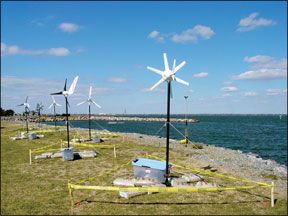
288
Starzinger. We bought the 403 model in 1998, and it worked flawlessly. It was a noisy one, and when the new Air-X model came out in 2004, we were given a decent allowance to trade in our 403. The new Air-X turbine is much quieter. When the apparent wind speed is above about 15 knots, the Air-X provides all the energy we need for fridge, freezer, radar, autopilot, nav instruments, and some left over for battery charging. It also keeps our batteries topped up over the winter, in snow, rain, and freezing temperatures. Its perhaps not fair to criticize it at anchor or in a marina, where the location is deliberately chosen to be protected from the wind.
Emanuel Laufer
Ceol Mor
, C&C 34Halifax, Nova Scotia
Noise and lack of output in comfortable conditions (living aboard in 15 knots of apparent wind can get old) were Evans chief complaints; and yes, his was the older, louder model (as was mentioned in the article). We were in the middle of our wind generator test when this issue went to the printer. After two breezy days of testing on Chesapeake Bay, the newer model Air-X was doing quite well.
Iron Clad Argument
Id like to chime in on the iron vs. lead ballast conversation (Practical Sailor Advisor, January 2007).
I have a 1985 Contest 36 with external iron ballast in the form of a winged keel. I have been able to stay ahead of rust problems with the use of a power drill with a wire brush wheel and about four hours of my time each spring. I brush out the rust spots down to bare, shiny metal, and immediately apply zinc chromate (not the gray spray stuff, but the yellow paint stuff). I put on a second coat the next day, followed by bottom paint. An internal, encased iron
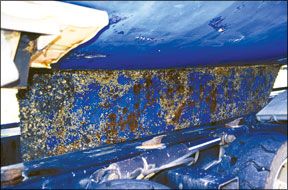
288
ballast (like that on the Cabo Rico that reader Kelly Arnold was concerned about in the Practical Sailor Advisor) has much less exposure, and theres less likelihood of problematic rusting. I have an iron I-Beam under my compression post in the bilge, so it is occasionally exposed to moisture. It has a factory barrier coating and no rust! Bottom line is that if you love everything else about your boat, don’t turn your back on it because of something that is likely a non-issue.
Greg Costello
Surprise
, Contest 36Milford, Conn.
In a nutshell, when it comes to ballast, iron is less dense, shorter lived, cheap alternative to lead. At minimum it means more work. As a worst-case scenario, it can play out as a capsize caused by high carbon-steel keel bolts rusting enough to snap off and drop the ballast keel to the bottom. In the case of encapsulated ballast, rust creates pressure as it expands, and it can be enough to rupture the encapsulation. Yes, iron is fine, but rusting makes it disappear.
Rudder stock Wither?
In the February 2007 issue, there was a great article, “Keep a Close Watch on Marine Metals,” by Ralph Naranjo. I was a little confused by the story that began the article, an analysis of the rudder in the Indian Ocean. I understand that stainless steel in the absence of oxygen will corrode easily. It seems to me that stainless steel would not have any advantage in the encapsulated environment of the described rudder. Would not this be the worst environment for stainless steel, no oxygen, and lots of moisture (eventually, because of the described expansion and contraction and non-bonding between the stainless steel and the resins)?
Clifford Kurz
Jamestown, R.I.
We forwarded you letter on to
Practical Sailor Technical Editor Ralph Naranjo. He had this reply: “Single data-point concerns often complicate marine material discussions. In this case, 316L stainless steel, though less than perfect, is a sensible, cost-effective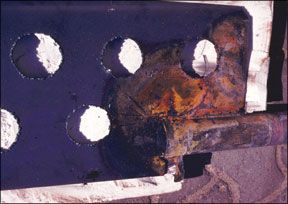
288
compromise for rudder stock construction. (Note that the rudder stock is often incorrectly called a rudder post, which is a different part altogether.) Its behavior in an oxygen-reduced situation is a minor issue in comparison to high carbon steels proclivity to rust, expand, and explode the rudder blade as well as bind in the bearings. Aluminum is too galvanically active for a rudder stock in saltwater, and carbon fiber, very appropriate for rudder stocks, remains very costly.
“The key attribute of a good rudder stock lies in it being a stiff and strong, continuous, one-piece member running from the head where a tiller can be attached, into the rudder blade (about 3/4ths the way to the tip).
“Rotational loads developed by the blade are transferred to the stock by way of substantial welded gussets buried within the blade. These forces combine with the bending moment associated with the lift and drag as well as physical contact with obstacles, all tallying up as the total rudder load. Ideally, differing pressures at different points along the structure would be met with varied tube thicknesses and shape changes that better conform to the blade itself. This is why a carbon/epoxy laminate is such an appropriate material for a rudder stock.
“Encapsulated, galvanized high carbon steel could be used inside the blade, but it must be transitioned to a tube-type stock of a much less rust-prone material. It makes little sense to engineer such a junction when a properly designed stainless steel-gusseted tube serves the purpose and is easier to make.
“The buried armature in the foam-filled blade may be oxygen-starved, but it is not immediately adjacent more noble metals like a bronze strut or through-hull, so corrosion is less of an issue. Its also easy to build in an additional safety margin in the form of multiple gussets that spread the load.
“There are several factors at play in the rudder failure aboard this Ericson 41, with the most consequential being an engineering flaw caused by the rudder builder (Foss Foam) ignoring the designers intention to have a one-piece rudder stock run most of the way down the blade itself. Instead, the subcontractor saved a couple of feet of expensive stainless tubing by butt welding a mild steel plate to the stock that had been terminated just inside the rudder blade. This resulted in tube loads being focused on the flat plate welded to the zero axis of the structure. A stress riser was created at the joint, and cyclic loading caused the dissimilar metal welds to fail. Corrosion was a secondary issue, the main problem was the way in which rudder loads were transferred to the tubular rudder stock. The right way to have built the rudder would have been to extend the tubular rudder stock deeper into the blade and welded stainless steel gussets closer to the tube sides rather than on the centerline. Even better would have been a carbon-fiber rudder stock that could be molded into a shape that best fits the internal contour of the rudder blade, and would efficiently pick up and transfer all of the rudder loads.”
Prop Shaft Worries
I just finished reading Mr. Naranjos thorough, and somewhat horrifying, article on marine metal failure. Like most people, Ive got a stainless prop shaft with a bronze prop. Im concerned about the stainless being immersed in water-where there is no air. Im also worried about the dissimilar metal interaction between prop and shaft. I do replace the sacrificial zincs on the shaft religiously. Should I still be concerned?
Paul Bradley
Beacon Falls, Conn.
Dont worry too much about a bronze prop and a stainless steel shaft. Just keep the sacrificial zinc in place. Replace the zinc annually, even if it looks like half of the metal is still on the anode. The ideal shaft material is monel, a very noble metal, but also a very costly one. The next best option is a high nickel-content alloy called Aquamet, and its corrosion resistance increases with the designating number. The recommended range for marine use is 17 to 22; the latter is what the best boatbuilders use for shaft material. Aquamet 22 is todays best choice.
Tether Snap Hooks
I want to comment on your January 2007 article on safety tethers and your top pick, the West Marine Elastic with a Wichard Hook. I owned one and found it extremely frustrating. The clasp was stiff to open and required the hand to be in exactly the right place to open it. I struggled each time I went to unclip myself, and just couldnt unclip quickly.
My husband and several of our friends (all male) also have one. They have no problems with them. My theory is that, as a woman, I just don’t have enough strength in my hands to use it properly.
It all came to a head in April, when we had to beat into a heavy squall to finish a 24-hour race. It was hailing, blowing a gale, and we were tacking every few minutes. I had thick gloves on and could not unclip in time to move across to the other rail. I realized that this was a huge safety issue and decided to spend another $100 on a different system. I bought the West Marine tether with the Gibb hook, used it in a race across the Pacific, and have had no more problems.
I recommend that people try opening the Wichard hooks, in the store (preferably wearing their thickest sailing gloves) before they decide to buy. It may be very safe, but it doesn’t help you if it stops your being able to move around.
Nicola Lott
Alchemy
, J/35Vancouver, Canada
West Marines newest tether (reaching store shelves this month) recently unseated its tether with the Wichard hook for our Best Choice title. The new one is equipped with a Kong snap hook (see page 23). Testers found the Kong lighter and easier to open than the Gibb, which we also recommend.
Waxing Ecstatic
Your article “To Shine and Protect” (March 2007) caught my eye because I am one of those people that have better things to do than run a buffer at age 66-namely cruise the San Juan islands and fish a little. About nine months after having my boat professionally waxed, I
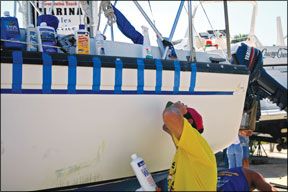
288
noticed oxidation starting to show-not a big surprise. The next day, I saw an orange container of Nu Finish, “The once-a-year car polish.” The container said it was good for many things, including fiberglass boats and chrome. I tried a 2-foot-square area, and it looked good. A second coat looked even better, so I applied two coats of this product to the hull and topside. I have used this product for three years on my boat, which is moored in an uncovered slip in Anacortes, Wash. Two coats are good for nine to 12 months. At Wal-Mart last year, this item was less than $10 for a 16-ounce bottle.
Tom Cammack
Uniflite 32 (sportfishing boat)
Anacortes, Wash.
Look for an update on hull restorers like Poli-Glo in next months issue. Well be conducting longterm tests of hull-restorers and waxes this year, so we encourage readers to send in suggestions while we round up the usual suspects.
Waxes to Test
In regard to your hull wax test, I think two that should be included are Klasse All In One and Zaino All In One. Both are considered the pinnacle of auto care in shine and durability, and they can be used on fiberglass, too. I would love to see you guys test these against the current products you are testing.
Douglas Rowe
Via e-mail
Brand Loyalty?
I enjoyed the article on one-step waxes (February 2007). In your opinion, is there a benefit to staying in a product “family,” or can you cherry-pick the best washes, polishes, waxes, from different manufacturers? Also, a very good cleaner-wax you might consider for review is Gel-Gloss (a non-marine product), recommended to me by a professional detailer.
Dave Entner
Via e-mail
While several manufacturers try to suck you into their product line with suggestions that you first clean the hull with their cleaner, etc., weve found in our testing that there is generally no great benefit to sticking with one product family. One brand of nonskid cleaner might do well, but the same companys black streak remover might not perform as well. This was the case with 3Ms nonskid (rated Excellent in Feb. 15, 2005) and 3Ms black streak remover (rated Poor in May 2006).
Practical Sailor
has tested just about every type of cleaning/waxing product in the past three years. Heres a list of top performers: Boat wax-Collinite (Nov. 15, 2004); nonskid cleaner-3M, West Marine, Meguiars (Feb. 15, 2005); barnacle remover-Star brite (May 1 2004); waterline stain remover-Aurora (July 1, 2004); One-step wax-Collinite 870 (March 2007); black streak remover-Nautical Ease (May 2006); metal polish-Miracle Cloth (March 2007).Tempted by Wi-Fi
I saw that you are looking for letters from readers using Wi-Fi on boats. We are located in Marsh Harbor, Abaco, Bahamas, and will be moving south soon. Our boat, Callisto, is a 1986 Ebbtide 33 (steel English cutter) designed by Alan Pape. Because we are a steel boat, it became obvious that if we wanted to use our computer at our nav station instead of outside in the cockpit, an external antenna would be necessary. It was also our experience that although we were able to see many wireless “hot spots,” we were only able to log on to the ones nearby. I attributed this to the low 20 mW transmit power of the internal Wi-Fi card installed in our Dell Latitude 505 laptop computer.
We purchased a 2.4 GHz, 8.5 dB Omnidirectional Wireless LAN Marine AntennaHyperGain HG2409UM and coupled it with a H-PC325-G-1 Professional 802.11b PC-Card. The combination of the externally mounted 8-dB antenna and the increased 200-mW transmit power of the PC card have worked well for us in most locations from New
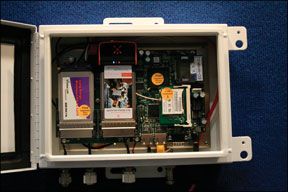
288
England to the Bahamas. It also allows us, in many cases, to use Skype from the comfort of our own boat and eliminates the need to go ashore to an Internet cafe. With the exception of the physical mounting of the antenna, everything was plug-n-play. The only difficulty with the above combination is the delicate MMCX antenna connectors on the PC card. The pigtails do not stand up to any rough treatment, and weve ordered a spare pigtail.
Bob and Bobbie Allen
Callisto
, Ebbtide 33Marsh Harbor, Abaco, Bahamas
We found your antenna for $123 at
www.netgate.com. Thats a whole lot less than some of the sophisticated devices we saw at the Miami Boat Show in February. We are moving ahead full steam on a test of various “marine-grade” Wi-Fi antennas like the one you describe. From our perspective, the downside of this technology is the increasing number of e-mails we will be getting from exotic locales like Marsh Harbor, sure to inspire bouts of nostalgia for the cruising life.Another Wi-Fi Tempter
Regarding your search for better Wi-Fi connections: The key to wireless onboard computing is transmit power and antenna gain. The SMC 2532W-B 802.11b PCMCIA card has four times the normal power level. You can combine that with antennas of increasing gain to increase range. The SMC ANT-OM5 gives a 5-dB gain with an integrated antenna. This works in most marinas. SMC also makes directional antennas with gain up to 14 dB (SMC ANT-DI145), which can be used with a base and the appropriate cable. The high-gain antenna that I use is an Echo Backfire 14-dB antenna with a 2-foot MMCX/N male RG-174 cable. This, combined with the 2532W card, has allowed me to get connected to the access point at the Warderick Wells ranger office in the Bahamas from a distant anchorage.
George Gidzinski
Island Girl,
Cabo sportfisherVia e-mail
We get the distinct impression there are more folks in the Bahamas or other enviable locations willing to share their Wi-Fi setup in the interest of science. Bring them on.
Raymarine Woes
Your readers may be interested in a problem I have experienced with Raymarine. In April 2005, I purchased an L365 Fishfinder (Serial No. 1210398088) with an M78923 bronze through-hull transducer for use as a depth sounder and log aboard our cruising sloop. After a few weeks of use, it started to read in hundreds of feet when the known depth was less than 50.
This happened after 15 minutes of use. As we were then on an extended trip, we could not send it back for warranty repairs until the end of the season. This meant I could not use the log as I had to limit the units use for times when actual depths were required.
This spring, we found that the plastic plug that holds the log paddle was cracked, causing the through-hull to leak. A replacement was ordered in early June. We were told in late July that Raymarine no longer stocks the part. After writing them for assistance, they have just informed us we must go to the original manufacturer of the through-hull. The blank plug has had to be inserted, leaving us with no log for a second season. If I cannot find the part, I will have to replace the unit.
Gerry Peer
Allied Seawind 30
New Brunswick, Canada
We contacted Raymarine and the tech support there suggested buying a new bronze transducer-to the tune of $150 or more, depending on where you buy it. Meanwhile, Mr. Peer was able to track down the part he needed from Airmar, which manufactures the transducers for virtually every make and model depth sounder. The piece cost about $35, including shipping and duties. Interestingly, the new part came with a warning to remove the plastic log plug during winter storage, so that it doesn’t freeze and crack. As far as we can tell, that warning was absent in the Raymarine manual.
Diaphragm Pump Dilemma
I have a 12-volt Jabsco (36600) diaphragm bilge pump, and on three separate occasions, a rivet holding the rubber valve to its crown failed. What Im interested in determining is whether you have received complaints from others regarding these Jabsco pumps, particularly the failure of the valves. I am looking for a reliable, rock-solid replacement.
John Wall
Bethesda, Md.
Contributor Bill Seifert, author of “200 Essential Passagemaking Tips,” once had a fine collection of failed diaphragm pumps, partly because he likes them for bilge pumps and wanted to find a good one. He told us that he has rarely experienced the type of failure you report-we have received none here-and that usually, the diaphragm goes before the rivet. He suspects that stray DC current may be at work here and recommends you check for that. In his experience, the Whale Gulper is a reliable diaphragm bilge pump. We will be initiating a new round of bilge pump testing, and well be sure to include diaphragm pumps in the mix. Our last bilge pump test (Feb. 15, 2004) focused on centrifugal pumps.


































